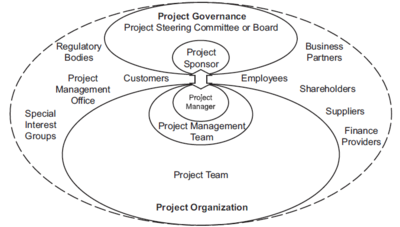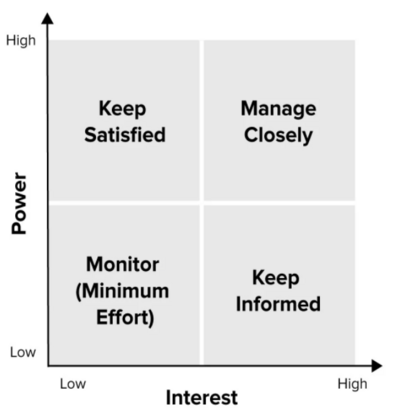Stakeholder management
(→Stakeholder analysis) |
(→Stakeholder analysis) |
||
| Line 27: | Line 27: | ||
4. Assessment of stakeholder importance | 4. Assessment of stakeholder importance | ||
| + | The assessment of the stakeholders’ importance are assigned to three characteristics. (attitude, power and influenceability). A simple method to outline these three assessments is mentioned below. | ||
| + | • The attitude indicates the stakeholder’s level of support for the project. Attitude has integer values in the range [−3, +3], where “−3” means strong opposition and “+3” means strong support. A higher absolute value of attitude is associated with a higher level of importance of the stakeholder. | ||
| + | |||
| + | • The power of the stakeholder is associated with a higher level of importance in terms of resources etc. Power has values of 1, 2 or 3, and is corresponding to low, medium, high range. A higher value of power is associated with a higher level of importance of a stakeholder. | ||
| + | |||
| + | • The influenceability indicates the ease with which the projects key player can change the stakeholders’ attitude toward the project. Influenceability has the same algorithm as for the power. A higher value of influenceability is associated with a higher level of importance of a stakeholder | ||
5. Setting objectives for engagement | 5. Setting objectives for engagement | ||
Revision as of 15:11, 23 February 2021
Contents |
Abstract
The prerequisite for creating a successful project, program, or portfolio is to identify the views of different actors. A key element is, therefore, to ensure good stakeholder management. For all projects, programs, or portfolios, it is crucial that the stakeholder's needs within communication, commitment, and systematic management are handled correctly. The purpose of manage stakeholders is to give appropriate understanding and attention to stakeholders' needs and expectations. This process includes activities such as identifying stakeholder concerns and resolving issues.[1]
Strong stakeholder management enables better cooperation with other actors and thus ensures that the interests of all parties are satisfied. To ensure strong stakeholder management, there are several models and tools that can be used in all types of projects. This article explains how stakeholder management is used in practice. There will also be made an in-depth analysis of individual key models and a discussion about possible limmations that can occurs by using these models.
Stakeholder classification and organization
In a project, The stakeholders are placed in different subcategories. The purpose is to create an overview of the project participants. A distinction is made to identify the internal and external stakeholders and their roles in the different phases of the project. It is therefore important to classify each stakeholder. Figure xx shows an overview of a classic organization chart of a project team and a steering group. The project manager is responsible for the project team, which can vary in size depending on the project scope and complexity. The project team must be able to provide the necessary professional competence to solve technical problems in connection with the project. The project manager's responsibility is to pass on the decisions that are discussed in the steering group to the project team. The steering group helps to set requirements for the project's quality, finances, and general project development. In this organizational structure, there are some other stakeholders who contribute other essential competencies and knowledge. These stakeholders are found in the outer circle of the project organization as shown in the figure. These actors can, e.g., be finance providers, business partners, and customers.
Stakeholder analysis
Project managers can use the stakeholder analysis to identify the key actors and to assess their knowledge, interests, positions, alliances, and importance related to their needs. This allows the project managers to interact more effectively with key stakeholders and to increase support for the project. By applying this analysis tool in project planning, the project managers can detect and act to prevent misunderstandings, and the project is more likely to be a success.[2] A detailed stakeholder analysis provides and assists the project in developing a structured strategy. As mentioned earlier, the stakeholders can act as individuals or groups who can be affected by any considerations. The stakeholder analysis is a dynamic method and is therefore not a strictly defined method. The method must be adapted to the current project and its difficulties. The method should be apt to deal with complexity and on the strategic level. The stakeholder analysis consists of 5 major steps: [3]
1. Definition of the entity’s stakeholding.
The definition of the entiny's stakeholding consists of two loops. The first part is to identify how the entity can impact the project. A simple tool is brainstorming, as it outlines a lot of important aspects of the stakeholder’s entity to the project. the process is repeated to sort in the list so that only the most essential aspects are included.
2. Classification of spontaneous stakeholding.
This step involves listing all the forms of spontaneous stakeholding that apply to this entity. A spontaneous stakeholder is defined as an entity that has an interest in the project regardless of any role that they might be commissioned to fill. We propose a taxonomy of six generic classes of spontaneous stakeholders in a project. These six classes are the funders, beneficiaries, positive impactees, negative impactees, customers, and influencers.
3. Identification of any consequences
By Identifying the consequence relating to the stakeholders, the potential risks can be highlighted. The risks can then prioritize in a smart way and at the same time identify suggestions for solutions in advance. The severity of a risk is defined by a combination of the probability of it happening and the consequences of if it is either to be prevented or remedied, based on what it costs you in terms of resources as a project manager, either having to prevent or repair the individual risk. Obvious consequences, such as stakeholders being unhappy about the project are likely to foment opposition and should be identified here.
4. Assessment of stakeholder importance
The assessment of the stakeholders’ importance are assigned to three characteristics. (attitude, power and influenceability). A simple method to outline these three assessments is mentioned below. • The attitude indicates the stakeholder’s level of support for the project. Attitude has integer values in the range [−3, +3], where “−3” means strong opposition and “+3” means strong support. A higher absolute value of attitude is associated with a higher level of importance of the stakeholder.
• The power of the stakeholder is associated with a higher level of importance in terms of resources etc. Power has values of 1, 2 or 3, and is corresponding to low, medium, high range. A higher value of power is associated with a higher level of importance of a stakeholder.
• The influenceability indicates the ease with which the projects key player can change the stakeholders’ attitude toward the project. Influenceability has the same algorithm as for the power. A higher value of influenceability is associated with a higher level of importance of a stakeholder
5. Setting objectives for engagement
text
The classic stakeholder matrix
As stated in previous sections, many stakeholders contribute to the project in different aspects, and therefore it is essential to involve them throughout the project process. Based on the stakeholder classification and stakeholders' analysis, these stakeholders are placed into overall categories, allowing the managers to take action. The most commonly used stakeholder map is the power/interest matrix and is illustrated in figure xx. The matrix gives an overview of each stakeholder grouping relating to power and interest resources. The matrix divides the stakeholders into 4 different types depending on the level of influence.[4]
• Monitor: for those who have low power and low influence. This group should is placed in the exterior periphery, and therefore only a small amount of time and effort must be used.
• Manage closely: This group consists of the key players and has high power and significant influence. This quadrant is considered the most important. The stakeholders identified as critical players must be satisfied, and they must have major acceptability in the project's strategies.
• Keep Informed: They can influence the attitude of the most influential stakeholders. Their needs can be meet through information.
• Keep Satisfied: They are relatively passive stakeholders, but they can become to an interested party with high power and influence in case of poor decision-making.
The primary purpose of the matrix is to:
• Allow the project manager to have an overview of any stakeholder and their contribution
• Prioritize the requests and demands from the stakeholders
• Avoid conflicts between stakeholders and maintain common interests
• Make a guideline to channel the right amount of time to each stakeholder
• Predict future behavior and thereby reduce the risk for failure
text
Discussion
text
Conclusion
text
References
- ↑ ISO 21500 2012:E 4.3.10/
- ↑ "Stakeholder Analysis Guidelines" Kammi Schmeer:E Section 2/
- ↑ "Stakeholder Analysis" Eefie Cuppen:p.209-213/
- ↑ stakeholder matrix. https://www.mindtools.com/pages/article/newPPM_07.htm/

